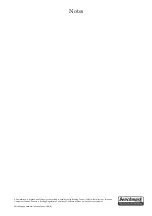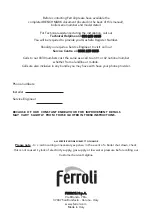
4
EN
BLUEHELIX 25K 50
3. INSTALLATION
3.1 General Instructions
B
This unit must only be used for its intended purpose. This unit is designed to
heat water to a temperature below boiling point and must be connected to a
heating system and/or a water supply system for domestic use, compatible with
its performance, characteristics and heating capacity. Any other use is deemed
improper.
THE BOILER MUST ONLY BE INSTALLED BY QUALIFIED PERSONNEL, IN COMPLI-
ANCE WITH ALL THE INSTRUCTIONS GIVEN IN THIS TECHNICAL MANUAL, THE
PROVISIONS OF CURRENT LAW, THE REQUIREMENTS OF THE TECHNICAL
STANDARDS (BS) AND ANY LOCAL REGULATIONS AND THE RULES OF PROPER
WORKMANSHIP.
Incorrect installation can cause damage or injury for which the manufacturer cannot be
deemed responsible.
The unit must be installed in compliance with these instructions and the following
standards applicable in Great Britain.
Gas Safety Regulations (Installations & Use).
Local Building Regulations.
The Building Regulations (Part L).
The Buildings Standards (Scotland - Consolidated) Regulations).British Standards
Codes of Practice (BSI):
Model Water By-Laws (Great Britain)
For Northern Ireland the relevant laws in force must be observed.
Safe handling of materials
Pay attention when handling the boiler insulation panels as they contain materials that
could irritate the skin.
No part of the boiler contains asbestos, mercury or CFC's.
The use of Personal Protective Equipment (PPE) is always recommended.
Advice for transport and handling
For lifting and transporting always take suitable safety precautions: keep your back
straight, bend knees, do not turn your body, move feet, avoid bending forward or side-
ways and keep the load as close as possible to your body.
If possible, use a trolley or other suitable means to carry the boiler.
Grip the boiler firmly and, before lifting it, try and find the point where the load is concen-
trated in order to establish the centre of gravity and suitably reposition yourself. Ideally
seek assistance in lifting the boiler.
3.2 Place of installation
The combustion circuit is sealed with respect to the place of installation and therefore the
unit can be installed in any room. However, the place of installation must be sufficiently
ventilated to prevent the creation of dangerous conditions in case of even slight gas
leaks. This safety regulation is provided for by EEC Directive no. 2009/142 for all gas
units, including those with a sealed chamber.
In any case, the place of installation must be free of dust, flam-
mable materials or objects or corrosive gases.
The boiler is arranged for wall mounting and comes standard with a hanging bracket. A
paper template for marking the drilling points on the wall is provided in the box. The wall
fixing must ensure stable and effective support for the boiler.
A
If the unit is enclosed in a cabinet or mounted alongside, a space must be pro-
vided for removing the casing and for normal maintenance operations. The min-
imum measurements to be respected are given in fig. 12.
fig. 12 - Minimum distances around the boiler
A
Min. 2,5 cm
B
Min. 20 cm
C
Min. 30 cm
D
Min. 60 cm (via an openable panel)
3.3 Plumbing connections
Important
B
The safety valve outlet must be connected to a funnel or collection pipe to pre-
vent water spurting onto the floor in case of overpressure in the heating circuit.
Otherwise, if the discharge valve cuts in and floods the room, the boiler manu-
facturer cannot be held liable.
B
Before installation, carefully clean all the system pipes to remove any residuals
or impurities that could affect proper operation of the unit.
In case of replacement of generators in existing installations, the system must
be completely emptied and cleaned of any sludge and pollutants. For that pur-
pose only use suitable guaranteed products for heating systems (see following
section), that do not harm metals, plastics or rubber.
The manufacturer de-
clines any liability for damage caused to the generator by failure to prop-
erly clean the system
.
Carry out the relevant connections according to the diagram in fig. 13and the symbols
on the unit.
fig. 13 - Plumbing connections
7 =
Gas inlet -
1/2”
8 =
DHW outlet -
1/2”
9 =
Cold water inlet -
1/2”
10 =
System delivery -
3/4”
11 =
System return -
3/4”
Antifreeze system, antifreeze fluids, additives and inhibitors
When necessary, antifreeze fluids, additives and inhibitors can be used only if the man-
ufacturer of such fluids or additives guarantees that they are suitable and do not cause
damage to the exchanger or other components and/or materials of the boiler and system.
Do not use generic antifreeze fluids, additives or inhibitors that are not specific for use in
heating systems and compatible with the materials of the boiler and system.
B.S.
5440
Part 1
Flues
B.S.
5440
Part 2
Air flow and ventilation
B.S.
5449
.........
Forced circulation hot water production systems
B.S.
6798
.........
Installation of gas-fired boilers for hot water
B.S.
6891
.........
Gas systems
B.S.
7671
.........
IEE wiring system standards
B.S.
4814
.........
Specifications for expansion tanks
B.S.
5482
.........
LPG systems
B.S.
7593
.........
Water treatment in central heating systems for DHW production
B.S.
5546
.........
Installation of systems for DHW production
B.S.
5955-8
.........
Installation of plastic pipes
D
A
A
B
C
10
8
7
9
11
17
2
F
23
4
174
41 69
149
117
132
92
cod. 3541F704 - Rev. 00 - 12/2018





































